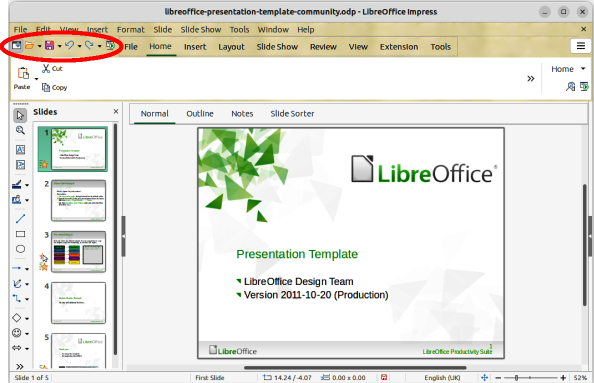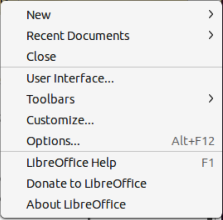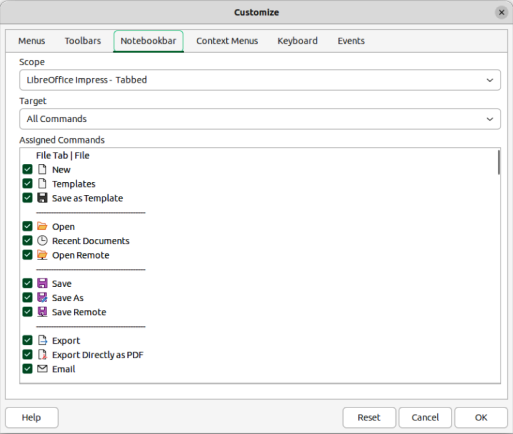

Impress Guide 7.5
Chapter 12,
User Interface Variants
This document is Copyright © 2023 by the LibreOffice Documentation Team. Contributors are listed below. This document may be distributed and/or modified under the terms of either the GNU General Public License (https://www.gnu.org/licenses/gpl.html), version 3 or later, or the Creative Commons Attribution License (https://creativecommons.org/licenses/by/4.0/), version 4.0 or later. All trademarks within this guide belong to their legitimate owners.
Contributors for this edition:
Peter Schofield
Contributors for previous editions: 1
Kees Kriek
Peter Schofield
Rachel Kartch
Vasudev Narayanan
Please direct any comments or suggestions about this document to the Documentation Team Forum at https://community.documentfoundation.org/c/documentation/loguides/ (registration is required) or send an email to: loguides@community.documentfoundation.org.
Note
Everything sent to a forum, including email addresses and any other personal information that is written in the message, is publicly archived and cannot be deleted. Emails sent to the forum are moderated.
Published June 2023. Based on LibreOffice 7.5 Community.
Other versions of LibreOffice may differ in appearance and functionality.
Some keystrokes and menu items are different on macOS from those used in Windows and Linux. The table below gives some common substitutions used in this document. For a detailed list, see LibreOffice Help.
|
Windows or Linux |
macOS equivalent |
Effect |
|
Tools > Options |
LibreOffice > Preferences |
Access setup options |
|
Right-click |
Control+click, Ctrl+click, or right-click depending on computer setup |
Open a context menu |
|
Ctrl or Control |
⌘ and/or Cmd or Command, depending on keyboard |
|
|
Alt |
⌥ and/or Alt or Option depending on keyboard |
Used with other keys |
|
F11 |
⌘+T |
Open the Styles deck in the Sidebar |
By default, commands and tools used in LibreOffice Impress are grouped in a user interface consisting of cascading menus and toolbars. The functions and use of these cascading menus and toolbars are described in previous chapters of this user guide.
This chapter describes the user interface variants that are available for LibreOffice Impress. A user then has the option to select the user interface that suits their requirements and methods of creating presentations in LibreOffice Impress.
Note
When changing the user interface, the variant can be applied only to LibreOffice Impress, or applied to all the modules in LibreOffice.
To select a user interface variant or switch between the user interface variants:
1) Go to View > User Interface on the Menu bar to open the Select Your Preferred User Interface dialog (Figure 1).
2) In UI variants, select one of the variants. An example of the selected variant is shown in the Preview box, along with a short description.
3) Click on Apply to Impress to immediately apply the variant selection to LibreOffice Impress only, or click on Apply to All to immediately apply the user interface variant to all the LibreOffice modules. The LibreOffice window changes to match the selected variant.
4) Click on Close to close the dialog.
Note
If the option Enable experimental features has been selected in the Tools > Options > Advanced dialog (macOS LibreOffice > Preferences > LibreOffice > Advanced), several more variants appear in UI variants. Being experimental, these variants are not described in this user guide.
Figure 1: Select Your Preferred Interface dialog

Figure 2: Standard User Interface dialog

The Standard Toolbar user interface is the default view when LibreOffice is installed and the Workspace opened for the first time. For more information on the Impress Workspace, see Chapter 1, Introducing Impress. Figure 2 shows an example of the default Workspace view in LibreOffice Impress consisting of the following:
Menu bar at the top of the Workspace.
Standard and Line and Filling toolbars positioned below the Menu bar.
Drawing toolbar positioned vertically on the left of the Workspace.
Sidebar on the right of the Workspace.
The Tabbed user interface provides a familiar interface for users coming from proprietary office suites, for example, Microsoft Office. Every tab within this user interface consists of a set of tools grouped by context. The context changes automatically depending on the LibreOffice module and the object selected. Figure 3 shows an example of the default Workspace view using the Tabbed user interface in LibreOffice Impress.
It includes a Menu bar, a Tab bar, and tool icons grouped in context that would be normally used in LibreOffice Impress. If the tool icons on a tab page do not fit into the width of the Impress window, a double chevron >> appears at the right end of the row. Click on the double chevron >> to display more commands.
Figure 3: Tabbed user interface

Figure 4: Quick Menu for Tabbed UI

At the left end of the Tab bar, an Icon bar (highlighted in Figure 3) is available giving access to some commonly used tools — Menubar; Open (Ctrl+O); Save (Ctrl+S);Undo (Ctrl+Z); Redo (Ctrl+Y); Start from First Slide (F5). In Windows and Linux operating systems, the Menu bar can be hidden or displayed by clicking on Menubar at the left end of the Tab bar.
On the right of the Tab bar, a quick menu (Figure 4), indicated by 3 horizontal lines (≡), is available giving access to some commonly used commands and links. Some of the quick menu items have submenus, indicated by a triangle ► or a single chevron > on the right.
The Tabbed user interface can be customized using the Notebookbar page of the Customize dialog (Figure 5) to show or hide the individual tools on the various tabs. For more information on customization of LibreOffice, see the Getting Started Guide and the Writer Guide.
Figure 5: Customize dialog — Notebookbar page

Note
When using the Tabbed user interface, the Impress toolbars are no longer visible. If necessary, it is possible to open toolbars by going to View > Toolbars on the Menu bar or select Toolbars on the quick menu.
The File tab (Figure 6) is a fixed tab providing commands to create new documents; open, save, print, and close documents; manage templates; export to PDF and EPUB; display document properties; add a digital signature; and sign an existing PDF. The File tab has two menus: File and Help. The File tab menu contains the same commands as the tools available on the tab and the Help tab menu provides links to a variety of resources.
Figure 6: Tabbed UI — File tab

The Home tab (Figure 9) is a fixed tab providing commands to cut, copy, paste, and format text; insert common items (for example images, tables, charts); apply, update, and edit drawing styles; and so on. The Home tab menu at the right end of the Home tab bar provides additional tools that are not on the tab.
Figure 7: Tabbed UI — Home tab

The Insert tab (Figure 11) is a fixed tab providing tools to insert many commonly used items. The Insert menu at the right end of the Insert tab bar provides some of the same tools.
Figure 8: Tabbed UI — Insert tab

The Layout tab (Figure 13) is a fixed tab providing tools to create a slide layout. The Layout menu at the right end of the Layout tab bar provides some of the same tools.
Figure 9: Tabbed UI — Layout tab

The Slide Show tab (Figure 16) is a fixed tab providing tools for creating a slide show. The Slide Show menu at the right end of the Slide Show tab bar provides some of the same tools.
Figure 10: Tabbed UI — Slide Show tab

The Review tab (Figure 18) is a fixed tab providing tools for reviewing a slide show. The Review menu provides additional text editing tools. Some of these tools appear only if Asian or Complex Text Layout are selected in LibreOffice options.
Figure 11: Tabbed UI — Review tab

The View tab (Figure 12) is a fixed tab providing tools to control the display of slides on a screen. The View menu provides additional tools relating to the slides display on a screen.
Figure 12: Tabbed UI — View tab

The Extension tab is a fixed tab containing only the Extension Manager tool. When selected, this tool opens the Extension Manager dialog allowing for installation and deletion of extensions that are compatible with LibreOffice.
The Tools tab (Figure 13) is a fixed tab providing several tools for macros; color replacer; media player; and so on. The Tools menu provides some of the same tools, plus extra tools for organizing, for example, macros and dialogs; image map; data sources; and so on.
Figure 13: Tabbed UI — Tools tab

Additional tabs appear between the View and Extension tabs when an applicable object in Impress is selected.
The Draw tab (Figure 14) becomes available when a drawing object is selected in a slide. It provides tools for editing, transforming, grouping, aligning, and distributing draw objects. The Draw tab menu provides some of the tools required for editing, transforming and converting drawing objects.
Figure 14: Tabbed UI — Draw tab

The Image tab (Figure 15) becomes available when an image is selected in a slide, for example a photograph. It provides tools for working with images, such as cropping, borders, area styles, colors, and so on. The Image tab menu provides links to dialogs for working with images.
Figure 15: Tabbed UI — Image tab

The Object tab (Figure 16) becomes available when an object, such as a chart, is selected. It provides tools to position, resize, choose colors, and so on for the selected object. The Object tab menu provides two extra tools to name and describe the object.
Figure 16: Tabbed UI — Object tab

Figure 17: Tabbed UI — Table tab

The Table tab (Figure 17) becomes available when a table is selected in a slide. It provides tools to format a table to the presentation requirements. The Table tab menu includes extra tools for editing a table.
The Media tab (Figure 18) only becomes available when a media object is selected in a slide. It provides tools for positioning and running an audio or video file. The Media tab menu includes extra tools for editing a media object.
Figure 18: Tabbed UI — Media tab

When selected, the Single Toolbar user interface only shows the Menu bar and the Standard (Single Mode) toolbar, as shown in Figure 19. However, toolbars can be added to the user interface by going to View > Toolbars on the Menu bar and selecting the required toolbar from the options available. For more information on toolbars, see Appendix B, Toolbars in this guide and the Getting Started Guide.
Figure 19: Single Toolbar user interface

When selected, the Sidebar user interface only shows the Menu bar with no toolbars. However, toolbars can be added to the user interface by going to View > Toolbars on the Menu bar and selecting the required toolbar from the options available. For more information on toolbars, see Appendix B, Toolbars in this guide and the Getting Started Guide.
The Tabbed Compact user interface has the same tabs as the Tabbed user interface, but the tools on each tab are arranged as a single row of tools. Some of these tools have drop‑down menus with extra options. The tab menu on the right of the Tabbed Compact user interface provides the same options as the tab menus in the Tabbed user interface. For more information see “Tabbed” on page 1 for more information.
The Groupedbar Compact user interface is divided into groups that contain commands organized as sets of tools and menus. The tools and menus that are available change to suit the type of object selected. If necessary, clicking on the double chevron >> displays more tools for editing an object. Figure 20 shows an example of Groupedbar Compact user interface.
The Menu on the right-hand end of the Groupedbar Compact interface provides extra tools for working with LibreOffice Impress, including convenient ways to change the user interface and access toolbars.
Figure 20: Groupedbar Compact user interface

The Contextual Single user interface displays a single toolbar to suit the type of object that has been selected. If necessary, clicking on the double chevron >> displays more tools for editing an object. Figure 21 shows an example of a Contextual Single user interface when a basic shape object is selected.
Figure 21: Contextual Single user interface
